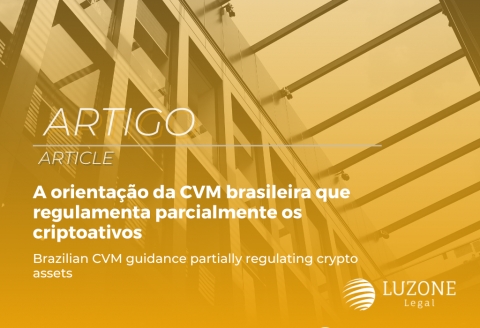A ORIENTAÇÃO DA CVM BRASILEIRA QUE REGULAMENTA PARCIALMENTE OS CRIPTOATIVOS
BRAZILIAN CVM GUIDANCE PARTIALLY REGULATING CRYPTO ASSETS

A orientação da CVM brasileira que regulamenta parcialmente os criptoativos
Em recente parecer, a Comissão de Valores Mobiliários brasileira publicou a Orientação 40, que trata das normas aplicáveis aos criptoativos que forem considerados valores mobiliários.
O documento explica que nem todo criptoativo poderá ser considerado valor mobiliário, de acordo com a Lei que criou a CVM, Lei n° 6.385/1976, que também dispõe sobre esse mercado.
A orientação é um passo na direção da definição de limites legais para a criptoeconomia, mas poderia ter sido mais ampla, levando o mercado a crer que a regulação de criptomoedas no Brasil ainda tem um longo caminho pela frente.
No entanto, é inegável que o parecer dá mais segurança jurídica ao mercado, confirmando entendimentos já praticados, enquanto não existe uma lei específica para tratar sobre o tema.
Como se sabe, a regulação de criptoativos é discutida mundialmente, e não seria diferente no Brasil. Ao tratar do tema, a CVM se mostrou aberta às novas tecnologias e prepara os primeiros passos para a regulação desse mercado.
A orientação serve, portanto, como um auxílio na área regulatória e serve para cumprir uma função consultiva para os agentes que atuam no mercado de valores mobiliários.
Em sua maioria, as questões colocadas no documento consolidam diferentes visões e orientações que a CVM já havia informado ao mercado de forma separada, por meio de precedentes e ofícios circulares anteriores.
O Brasil é reconhecido como o sétimo maior mercado de criptoativos do mundo, sendo que o volume de negociações de criptomoedas no país já equivale a 50% do total das operações da B3.
Equipe Luzone Legal
(...)
Brazilian CVM guidance partially regulating crypto assets
In a recent opinion, the Brazilian Securities and Exchange Commission published Guideline 40, which deals with the rules applicable to crypto-assets that are considered securities.
The document explains that not every crypto asset can be considered a security, according to the Law that created the CVM, Law No. 6,385/1976, which also provides for this market.
The guidance is a step towards defining legal limits for the cryptoeconomy, but it could have been broader, leading the market to believe that cryptocurrency regulation in Brazil still has a long way to go.
However, it is undeniable that the opinion gives more legal certainty to the market, confirming understandings already practiced, while there is no specific law to deal with the subject.
As is well known, the regulation of crypto-assets is discussed worldwide, and it would be no different in Brazil. When dealing with the subject, the CVM was open to new technologies and is preparing the first steps for the regulation of this market.
The guidance therefore serves as an aid in the regulatory area and serves to fulfill an advisory role for agents operating in the securities market.
Most of the questions raised in the document consolidate different views and guidelines that the CVM had already informed the market separately, through precedents and previous circular letters.
Brazil is recognized as the seventh largest cryptocurrency market in the world, with the volume of cryptocurrency trading in the country already equivalent to 50% of B3’s total operations.
Luzone Legal Team




